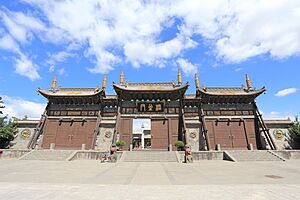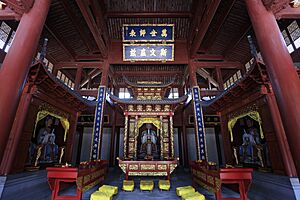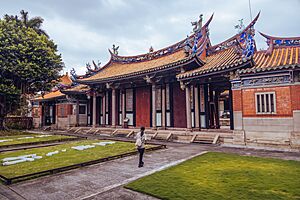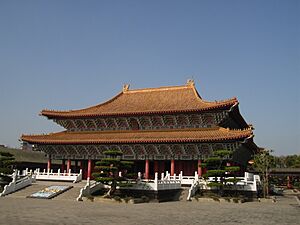Temple of Confucius facts for kids
Quick facts for kids Temple of Confucius |
|||||||||||
|---|---|---|---|---|---|---|---|---|---|---|---|

The Temple of Confucius in Qufu c. 1912
|
|||||||||||
| Chinese name | |||||||||||
| Traditional Chinese | 孔廟 | ||||||||||
| Simplified Chinese | 孔庙 | ||||||||||
| Literal meaning | Temple of Kong | ||||||||||
|
|||||||||||
| Temple of Literature | |||||||||||
| Traditional Chinese | 文廟 | ||||||||||
| Simplified Chinese | 文庙 | ||||||||||
|
|||||||||||
| Temple of the Sage | |||||||||||
| Traditional Chinese | 聖廟 | ||||||||||
| Simplified Chinese | 圣庙 | ||||||||||
|
|||||||||||
| Temple of the Master | |||||||||||
| Traditional Chinese | 夫子廟 | ||||||||||
| Simplified Chinese | 夫子庙 | ||||||||||
|
|||||||||||
| Temple of Study | |||||||||||
| Traditional Chinese | 學廟 | ||||||||||
| Simplified Chinese | 学庙 | ||||||||||
|
|||||||||||
| Palace of Study | |||||||||||
| Traditional Chinese | 學宮 | ||||||||||
| Simplified Chinese | 学宫 | ||||||||||
|
|||||||||||
| Vietnamese name | |||||||||||
| Vietnamese | Văn (Thánh) Miếu | ||||||||||
| Hán-Nôm | 文廟 文(聖)廟 |
||||||||||
| Literal meaning | Temple of (the Sage of) Literature | ||||||||||
| Korean name | |||||||||||
| Hangul | 문묘 공자묘 |
||||||||||
| Hanja | 文廟 孔子廟 |
||||||||||
| Literal meaning | Temple of Literature Temple of Confucius |
||||||||||
|
|||||||||||
| Japanese name | |||||||||||
| Kanji | 聖廟 聖堂 |
||||||||||
|
|||||||||||
| Indonesian name | |||||||||||
| Indonesian | Boen Bio | ||||||||||
| Manchu name | |||||||||||
| Manchu script | ᡴᡠᠩᡶᡠᡯ ᡳ ᠮᡠᡴᡨᡝᡥᡝᠨ | ||||||||||
| Möllendorff | kungfudzi-i muktehen | ||||||||||
A Confucian temple is a special building where people honor Confucius and other wise thinkers of Confucianism. Confucianism is a system of beliefs and ideas from ancient China. These temples are found in China and other East Asian countries.
Long ago, these temples were important places for learning. They were used for the imperial examination, which was a tough test to become a government official. Many temples also had schools and study areas. In Qufu, China, where Confucius was born, there is a huge 72-meter-tall statue of him made of brass and steel.
Contents
What are Confucian Temples Called?
Confucian temples have different names across East Asia. The two biggest temples, in Qufu and Beijing, are known as "Temples of Confucius" (Kǒngmiào) in Chinese.
Some places call them "Temples of Literature" (wénmiào). In Japan, they are often called "Temples of the Sage" (seibyō). These names show how much Confucius was respected for his wisdom and teachings.
History of Confucian Temples
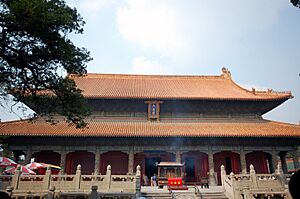
Confucius became more and more respected over time. This led to the building of state temples dedicated to him. In 195 BC, Han Gao Zu, the first emperor of the Han dynasty, honored Confucius at his tomb.
In 630 AD, the Tang dynasty made a rule that all schools in China should have a Confucian temple. This helped temples spread across the country. Famous temples include the one in Jianshui and the Confucian Temple in Beijing, built in 1302.
The largest and oldest Confucian temple is in Qufu, Confucius's hometown. It was built in 479 BC, just one year after he passed away. Over 2,000 years, it grew into the huge complex we see today. Besides these official temples, there were also family temples and private study halls.
How are Confucian Temples Built?
Starting in the Tang dynasty (618–907 AD), Confucian temples were built at schools. They were usually at the front or side of the school. The main entrance gate is called the Lingxing Gate.
Most temples have two or three courtyards. The temple in Qufu is much larger, with nine courtyards. The main building is called the Dachengdian, or "Hall of Great Achievement." Inside this hall, there were special tablets honoring Confucius and other important wise people.
In front of the Dachengdian in Qufu is the Apricot Pavilion. Another important building is the Shrine of Adoring the Sage, which honored Confucius's ancestors.
Unlike Taoist or Buddhist temples, Confucian temples usually do not have statues. In the past, some temples had paintings or statues. However, it was later decided that only "spirit tablets" should be used. These tablets were seen as a better way to honor Confucius's teachings, not just his image. Today, some modern temples do have statues, especially those run by Confucius's family.
How People Worship at Confucian Temples
Worship at Confucian temples mainly involved offering sacrifices to Confucius's spirit. A special dance called the Eight-Row Dance was also performed. This dance had eight columns of eight dancers each. Musicians played a type of music called yayue during the ceremony.
Besides Confucius, these temples also honor other important scholars and disciples. These include the "Four Correlates" and the "Twelve Philosophers". Over time, the list of honored figures grew. By the 20th century, 162 figures were honored.
The Four Correlates are Yan Hui, Zeng Shen, Kong Ji (Zisi), and Mencius. The Twelve Philosophers include famous students of Confucius like Zi-gong and Zi-Lu, and later scholars like Zhu Xi.
Confucian Temples Around the World
Confucian temples are not just in mainland China. As Confucian ideas spread, temples were built in Vietnam, Korea, and Japan. Some were even built in Europe and the Americas. At one point, there were over 3,000 Confucian temples!
Confucian Temples in Hong Kong

Hong Kong got its first Confucian temple in 2013. It was built near the famous Wong Tai Sin Temple.
Confucian Temples in Taiwan
The first Confucian temple in Taiwan was built in 1665 in Tainan. The Taipei Confucius Temple was built later, between 1925 and 1939. Its design shows the typical style from Fujian, a province in China. Every year on September 28, Confucius's birthday, a special ceremony is held there. Other temples can be found in Kaohsiung, Chiayi City, Taichung, and Changhua County.
Confucian Temples in Vietnam
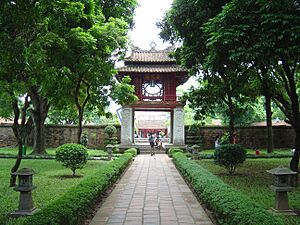
In Vietnam, Confucian temples are called Văn Miếu. The oldest one is the Văn Miếu in Hanoi, built in 1070. As schools spread in Vietnam, so did these temples. Other well-known temples are in Hưng Yên and Hải Dương.
Confucian Temples in Korea
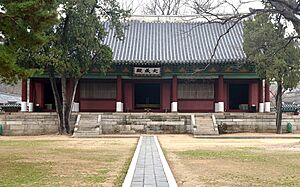
Korea has the most Confucian temples outside China. They were first built during the Goryeo period (918–1392). During the Joseon dynasty, Confucianism became very important for the government. So, government schools with temples were built everywhere to teach future officials.
These temples often had a teaching building and a main hall for memorial tablets. Korea also added its own scholars to the honored list. Historically, Korea had 362 Confucian temples. Many of the 232 temples in South Korea still operate today.
Confucian Temples in Japan
Kōshi-byō were also built widely in Japan, often with Confucian schools. The most famous is the Yushima Seidō in Tokyo, built in 1630. It started as a private school and later became a major state-sponsored school. Other well-known temples are in Nagasaki and Naha.
Confucian Temples in Indonesia

Confucian temples in Indonesia are sometimes called "Churches of Confucius" because Confucianism is a recognized religion there. The largest and oldest is the Boen Bio in Surabaya, built in 1883. There are more than 100 Confucian worship halls across Indonesia.
Confucian Temples in Malaysia
The first Confucian temple in Malaysia was built in a school in Penang in the early 1900s. Parents would bring their children to this temple to pray for good studies before school. There are also Confucian schools in Kuala Lumpur and Malacca that hold yearly ceremonies to honor Confucius.
List of Confucian Temples

- Temple of Confucius in Qufu, China (Confucius's home town)
- Temple of Confucius in Beijing, China
- Temple of the Master in Nanjing, China
- Temple of Confucius in Shanghai, China
- Temple of Confucius in Suzhou, China
- Temple of Confucius in Jianshui, Yunnan, China
- Temple of Confucius in Daixian, Shanxi, China
- Temple of Confucius in Taipei, Taiwan
- Temple of Confucius in Taoyuan, Taiwan
- Temple of Confucius in Taichung, Taiwan
- Temple of Confucius in Kaohsiung, Taiwan
- Temple of Confucius in Tainan, Taiwan
- Temple of Confucius in Changhua, Taiwan
- Temple of Confucius in Chiayi, Taiwan
- Temple of Confucius in Nagasaki, Japan
- Shiseibyō, the Temple of Confucius in Naha, Okinawa, Japan
- Seibyō, the Temple of Confucius in Taku, Japan
- Yushima Seidō, the Temple of Confucius in Tokyo, Japan
- Munmyo, the Temple of Confucius in Seoul, South Korea
- Văn Miếu in Hanoi, Vietnam
- Văn Miếu in Hưng Yên, Vietnam
- Văn Miếu in Hải Dương, Vietnam
- Văn Miếu in Bắc Ninh, Vietnam
- Văn Miếu in Nghệ An, Vietnam
- Văn Miếu in Khánh Hòa, Vietnam
- Văn Miếu in Đồng Nai, Vietnam
- Văn Miếu in Vĩnh Long, Vietnam
- Boen Bio in Surabaya, Indonesia
Images for kids
-
The Temple of Confucius in Jiading, now a suburb of Shanghai. The Jiading Temple of Confucius now operates a museum devoted to the imperial exam formerly administered at the temples.
-
The Hall of Great Achievement of the Temple of Confucius in Harbin, Heilongjiang.
See also
- Confucian churches
- Mansion and Cemetery of Confucius
- Wenchang Dijun (文昌帝君)
- Supreme Council for the Confucian Religion in Indonesia
- Taoist temples
- Buddhist temples


